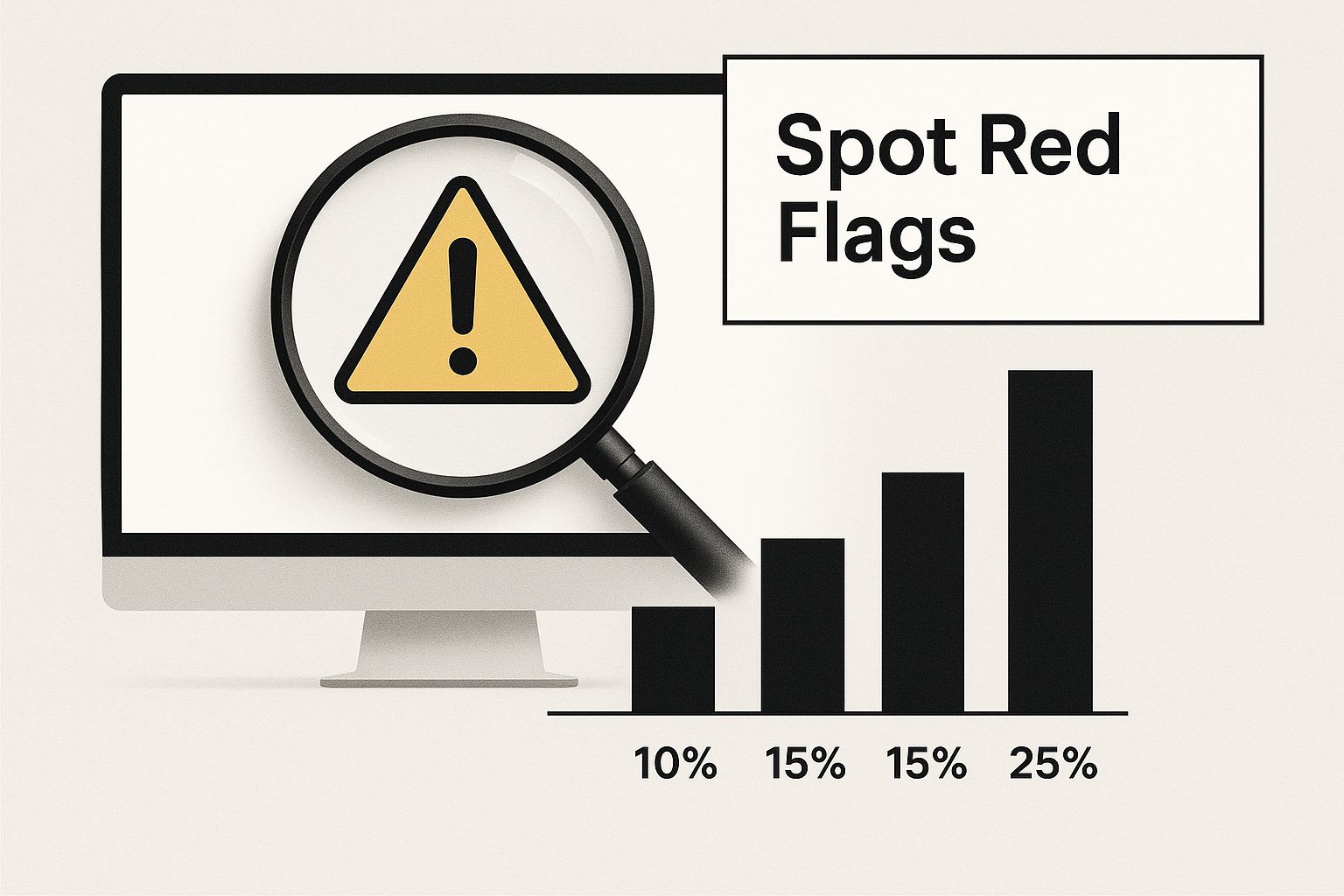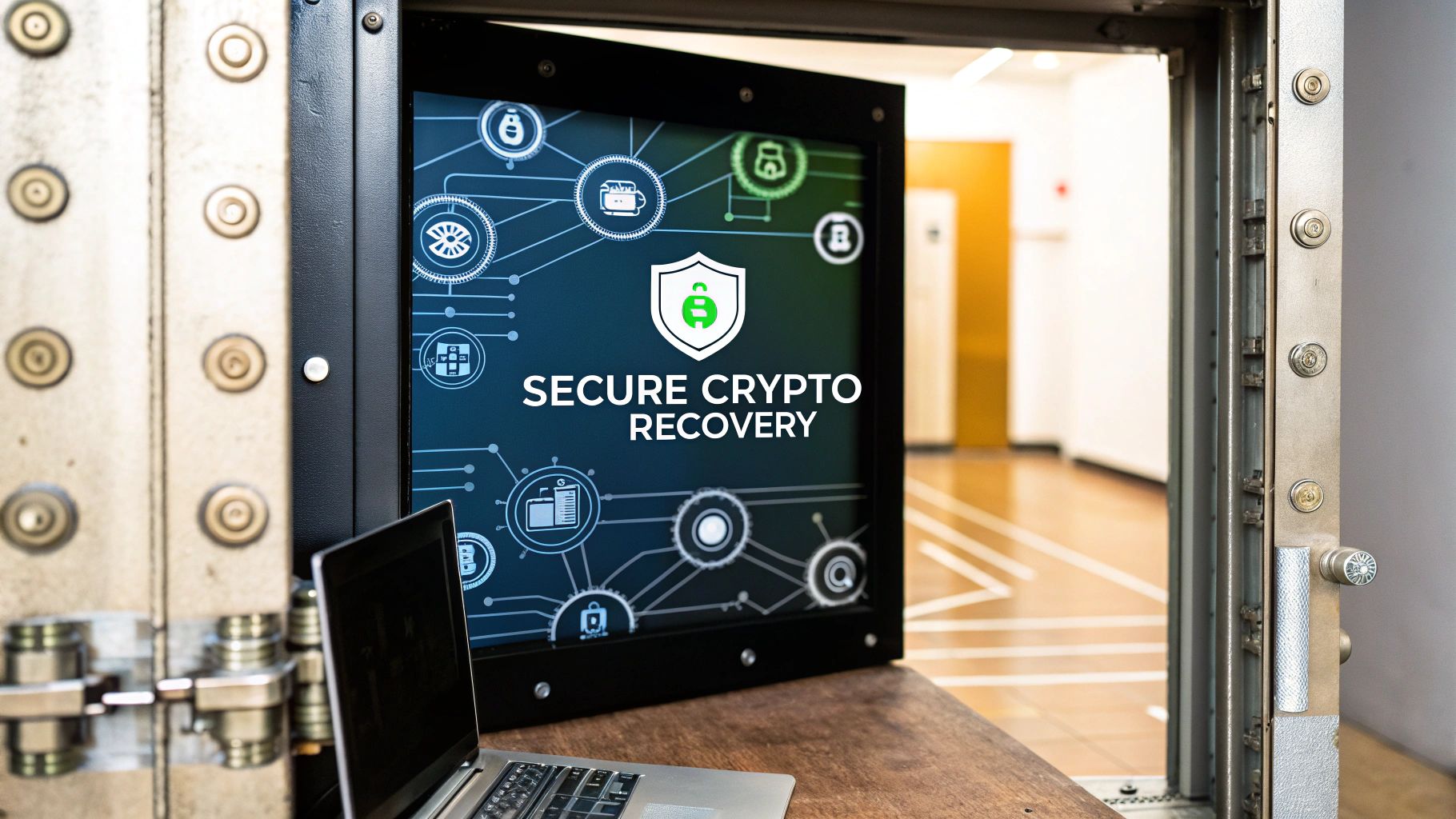That sinking feeling in your stomach when you realize you can't access your crypto wallet is awful. It's a mix of panic and dread, and your first impulse might be to try anything and everything to get back in.
But this is precisely the moment to slow down. The next few hours are absolutely critical, and any rash decisions could permanently lock you out of your funds. Before you do anything else, take a breath.
What to Do Right After Losing Crypto Access

The moments immediately following the discovery are a high-stakes game where every move matters. Whether you've blanked on a password, think you've been hacked, or clicked a link you shouldn't have, your first steps will make or break your recovery chances. The goal is to switch from panic mode to methodical action.
And if this has happened to you, know you're not alone. This is a surprisingly common issue. An estimated 20% of all Bitcoin—worth a staggering $140 billion—is currently stuck in inaccessible wallets. This isn't just a niche problem; it's a massive global challenge, which is why understanding the state of crypto recovery is so important.
When you lose access to your crypto, your immediate actions are crucial. The right moves can set the stage for a successful recovery, while the wrong ones can make things worse. Here’s a quick-reference checklist to guide you through those first critical moments.
Your First Response Checklist for Lost Crypto
| Priority Action | Why It's Critical | Mistake to Avoid |
|---|---|---|
| Secure Your Digital Perimeter | If it's a hack, this stops further damage. Change passwords on related accounts (email, exchanges) and enable 2FA immediately. | Don't delete or alter anything on your computer. You might erase crucial evidence or data needed for recovery. |
| Document Everything | Create a detailed timeline of events. Note down every password variation, hint, or potential location of your seed phrase. Every small detail helps. | Don't rely on memory alone. The stress of the situation can make you forget important details. Write it all down now. |
| Preserve the Wallet File | Make a secure, offline backup of your wallet file (e.g., wallet.dat, Keystore JSON) as it is. Do not try to modify or "fix" it. |
Never send your wallet file or seed phrase to an unverified "helper" you find on social media or in a forum. Scammers are waiting. |
| Assess the Situation Calmly | Determine if you forgot a password, lost a seed phrase, or were a victim of a scam. The recovery path is different for each. | Avoid frantic, random password attempts. Many wallets lock up after a certain number of failed tries, complicating recovery. |
Following these steps methodically can transform a chaotic situation into a manageable problem. You've contained the issue, gathered the necessary information, and are now prepared to seek professional help without putting your assets at further risk.
Secure and Assess Your Situation
Your absolute first priority is damage control. If there's even a slight chance your accounts were compromised, lock everything down. Change the passwords on your email, your crypto exchange accounts—anything linked to your crypto activity. If you haven't already, turn on two-factor authentication (2FA) everywhere you can.
Think of it as applying a tourniquet. You need to stop the bleeding before you can even think about performing surgery. This initial lockdown prevents any more unauthorized access while you piece together what happened.
Document Every Single Detail
Now it's time to become the lead detective on your own case. Open a secure text document and start writing down everything you can remember. I mean everything. No detail is too small or irrelevant. This information is the raw material a professional recovery service will need to build their strategy.
Make sure to log these key details:
- Wallet Information: What kind of wallet is it? A MetaMask browser wallet, a Ledger hardware device, or something else? Note its public address, too.
- Transaction History: Jot down any relevant transaction IDs (hashes), dates, and amounts you can recall or find.
- Access Clues: This is the big one. Brainstorm every possible password variation, old passwords you've used, hints you might have left for yourself, or places you might have stashed a seed phrase.
- Suspicious Activity: Did you receive any weird emails or messages? Did you click on any unusual links right before this happened? Write it all down.
This log is, without a doubt, the most valuable asset you have right now. It gives a crypto recovery specialist the puzzle pieces they need to see the full picture and figure out if your funds are retrievable. Without it, even the best team is flying blind.
By taking these measured steps, you shift a chaotic, emotional event into a structured problem. You've secured your remaining assets, gathered vital evidence, and can now approach an expert with the clear, actionable information they need to get to work. This organized approach dramatically improves your odds of a successful recovery.
When you're panicked and desperate to get your crypto back, scammers see a golden opportunity. The crypto recovery space, unfortunately, is crawling with predators who prey on that desperation, often turning a bad situation into a catastrophe. Learning to tell a legitimate service from a scam is the most important thing you can do to protect yourself from getting burned a second time.
Scammers love to use high-pressure tactics and make wild promises because they know you're in a vulnerable spot. They create a false sense of urgency, hoping you'll act before you have time to think or do any real research.
This infographic breaks down some of the most common red flags to watch for.

Knowing these warning signs is your best defense against the tricks these fraudulent operators use.
Unrealistic Guarantees and Upfront Fees
The absolute biggest red flag? A 100% success guarantee. No one can promise that. The recovery process is incredibly complex and hinges on dozens of factors, many of which are completely out of a recovery expert's control. Anyone offering you a sure thing is just selling you false hope.
You should also be extremely wary of anyone demanding large payments upfront. Some services might charge a small, reasonable fee for an initial consultation or diagnostic, but demanding a significant sum before any real work has started is a classic scam. Reputable companies usually work on a success-based or hybrid fee model—they get paid the bulk of their fee after your funds are safely back in your control.
Think of it this way: if they're actually confident in their ability to get your crypto back, their payment structure will show it.
Demands for Sensitive Information
This one is a hard-and-fast rule. A legitimate service will never ask for your private keys or your full 12/24-word seed phrase. That information gives them total control of your wallet. Sharing it is like handing a stranger the keys to your entire digital life.
A real expert needs certain information to do their job, but your keys aren't part of it. Here’s a quick rundown of what's safe to share and what's not:
- Safe to Share: Your public wallet addresses, transaction IDs (also called hashes), and a detailed story of what happened.
- NEVER Share: Private keys, seed phrases, or any passwords to your crypto exchange or email accounts.
Any so-called "expert" who insists they need your seed phrase to "sync with the blockchain" or run a "diagnostic" is flat-out trying to steal from you. There are zero exceptions to this. A professional has methods to work with the data you provide without ever needing direct access to your wallet.
Lack of Professionalism and Transparency
Finally, just trust your gut. Take a good look at their overall operation. A scammer’s website often feels rushed, unprofessional, or just… off. You might notice a recently registered domain name, generic stock photos instead of real people, and no verifiable contact info or physical address.
A real company, on the other hand, will be transparent. They'll have a professional-looking website, clear ways to contact them, and a public presence. Look for case studies, profiles of their team members, and an established company history. If a service gets cagey when you ask about their methods, their team, or their track record, that's your cue to walk away. Choosing the best crypto recovery service always means going with the one that operates with total transparency.
What Real Recovery Methods Look Like (And What to Expect)
When you're trying to get lost crypto back, it's easy to fall for promises of a quick fix. But the reality is, genuine recovery work is highly technical and success isn't always guaranteed. The methods used by a legitimate crypto recovery service aren't magic; they're a mix of raw computational power and deep investigative work.
The path to getting your assets back really depends on what went wrong in the first place. A forgotten password is a completely different beast than funds swiped in a sophisticated exchange hack. Let's break down the actual techniques involved.
Brute-Force and Cryptographic Analysis
If you're locked out of a wallet because of a lost password or a corrupted file, the pros bring in the heavy machinery—computationally speaking. This is where you'll hear terms like "brute-force" attacks. It’s not as chaotic as it sounds; a specialized tool will systematically test trillions of password combinations.
This process becomes exponentially more effective if you can provide clues. Maybe you remember part of the password, like "SuperCat" followed by a four-digit year and a symbol. With that hint, the recovery service can target their search instead of shooting in the dark.
For wallet files that are damaged or corrupted, the approach is different. Experts use cryptographic analysis to dig into the file's structure, almost like digital surgery, to repair the errors that are keeping you locked out. These are highly specialized skills. If you're stuck with a locked Bitcoin wallet, for instance, you need someone who truly understands the specific techniques for Bitcoin wallet recovery.
Blockchain Forensics: The Hunt for Stolen Funds
When crypto is stolen, the game changes completely. The goal shifts to blockchain forensics, which is essentially digital detective work. This method doesn't involve "hacking back" the funds—that's a huge red flag if a service claims they can do it.
Instead, forensics experts meticulously trace the digital breadcrumbs your stolen assets leave on the public ledger. They use advanced analytical tools to follow the transaction trail from your wallet to the thief's, and then track where those funds go next. Often, the goal is to see if the thief tries to cash out at a centralized exchange.
Pinpointing that final destination is the key. It can potentially reveal the real-world identity of the person controlling the account. This hard evidence is then handed over to law enforcement or legal teams to take action.
It's a common myth that a crypto transaction can simply be reversed. Once it's confirmed on the blockchain, it's final. Success in theft cases comes down to tracing, identifying, and using legal channels or exchange policies to freeze or reclaim the assets.
A Realistic Look at Success Rates
So, what are the actual odds of seeing your crypto again? It varies wildly.
Legitimate firms often see success rates between 30% to 50% for complex theft and scam cases. The trail can go cold, or the thief can be skilled at covering their tracks.
On the other hand, for password and seed phrase recovery, the outlook is much better. Services with the right technology and expertise report success rates as high as 94-98%. The difference is stark, which is why it's so important to know what kind of problem you're dealing with.
To give you a clearer picture, I've put together a table comparing common recovery methods and the kind of success rates you can realistically expect in the industry.
Crypto Recovery Techniques and Realistic Outcomes
| Recovery Method | Best For | Typical Success Rate | Key Factor |
|---|---|---|---|
| Brute-Force Attacks | Forgotten passwords, especially with partial memory or hints. | 90%+ | The quality and accuracy of the password hints provided. |
| Cryptographic Repair | Corrupted or damaged local wallet files (e.g., wallet.dat). | 60-80% | The extent and nature of the file corruption. |
| Blockchain Forensics | Tracing stolen funds from hacks, phishing, or scams. | 30-50% | The speed of reporting and the thief's operational security. |
| Legal/Exchange Intervention | Funds traced to a regulated exchange or known entity. | 20-40% | Cooperation from exchanges and law enforcement agencies. |
Understanding these numbers helps you set realistic expectations from the start. It allows you to vet recovery services properly and find a specialist whose skills actually line up with your specific situation, giving you the best possible shot at getting your funds back.
How to Safely Work with a Recovery Specialist

Alright, you've done your homework and found a service that looks promising. It’s a big step, but this is where you need to be more careful than ever. Engaging with a recovery specialist isn't about handing things over and hoping for the best; it’s a methodical process where you remain in control.
Think of the first consultation as a two-way interview. They're sizing up your case, sure, but you should be grilling them. A legitimate firm will be patient, transparent, and ask smart, specific questions.
Before you share a single sensitive detail, bring up a Non-Disclosure Agreement (NDA). This is standard practice. If they brush it off, hesitate, or don't have one ready, walk away. That's a massive red flag waving right in your face.
What to Share and What to Guard
With an NDA signed, you can begin to share the info they need. But there's a hard line between what's helpful and what's reckless. This isn't a gray area—it's black and white.
A real pro will ask for things like:
- Public Wallet Addresses: This lets them analyze the blockchain data without touching your funds.
- Transaction IDs (Hashes): These are like breadcrumbs they use to trace stolen or lost crypto.
- Your Detailed Story: A clear, documented timeline of what happened is surprisingly one of the most powerful tools you can give them.
On the flip side, a legitimate service will NEVER, EVER ask for the keys to your kingdom. If you hear any of these words, the conversation is over.
- Private Keys
- Your 12 or 24-Word Seed Phrase
- Passwords to your email or exchange accounts
There is absolutely no technical reason a recovery expert needs your private keys or seed phrase. Their work happens through forensic analysis, not by taking direct control of your wallet. Sharing this is the digital equivalent of handing a stranger the keys to your house and the title. Don't do it.
Your Pre-Engagement Checklist
Before you sign any contract or pay a dime, have your questions ready. You're not just hiring a service; you're entrusting them with a critical task. A trustworthy team will welcome the scrutiny.
Ask them directly about how they handle crypto asset recovery cases that mirror yours. Their experience with a forgotten MetaMask password is very different from tracing funds stolen from a compromised Ledger.
Here are the questions you absolutely must get answers to:
- Wallet-Specific Experience: "Have you successfully recovered funds from an Exodus wallet with this exact issue before? What were the results?"
- Data Security: "How is my case information stored? Who has access to it? And what’s your policy for destroying my data after the recovery attempt is finished?"
- Law Enforcement: "Do you ever work with law enforcement? If so, what does that process look like, and when do you get them involved?"
- Fee Breakdown: "I need a clear, written breakdown of all your fees. What happens if you only get part of the funds back? Is the fee structure the same?"
This final round of vetting keeps you in the driver's seat. By managing the flow of information and demanding transparency, you’ll find the best crypto recovery service for your situation without putting your remaining assets at risk.
Here is the rewritten section, crafted to sound like an experienced human expert.
How to Make Sure This Never Happens Again
Getting your crypto back is a massive weight off your shoulders. But the real win? Making damn sure you never have to go through that stress again. This whole ordeal is a tough lesson in self-custody, but it’s one you only have to learn once. It's time to build a real fortress around your assets.
Let’s be honest: most security slip-ups happen because we choose the easy route. A simple password on a software wallet feels convenient until it becomes a single, fragile point of failure. The goal isn't just to lock the door; it's to build layers of defense that make a breach practically impossible.
Your First and Best Move: Get a Hardware Wallet
If you do just one thing after reading this, make it this: move your long-term crypto holdings to a hardware wallet. Seriously. Devices from companies like Ledger or Trezor store your private keys in a completely offline environment.
Think about what that means. Your computer could be a cesspool of malware, but a hacker still can't get to your keys to sign a transaction.
The magic happens right on the device. When you need to send funds, the transaction is signed inside the wallet's secure chip. Your keys never touch your internet-connected computer. This simple step neutralizes a huge swath of common attack vectors, from phishing links to sneaky keylogging software.
Treat Your Seed Phrase Like Gold
That 12 or 24-word phrase is the master key to your entire crypto life. Protecting it is not optional, and scribbling it on a sticky note shoved in a desk drawer just isn't going to cut it.
Here’s how pros do it:
- Go Metal: Etch your seed phrase onto a steel plate. It's now fire-proof, water-proof, and won't fade or tear over time. It’ll outlast you.
- Split It Up: Store backups in at least two different, secure physical locations. A safe deposit box and a safe at home, for instance. This protects you from a single disaster like a fire or burglary.
- Stay Offline. Always. Never, ever take a picture of your seed phrase. Don't save it in a text file, a cloud drive, or your password manager. The second it becomes a digital file, it's vulnerable.
Your seed phrase is the deed to your digital property. You wouldn't upload a photo of your house deed to Instagram, right? Give your keys that same level of respect and physical security.
For Serious Holdings, Go Multi-Sig
Once your portfolio grows to a significant size, or if you're managing funds for a business or family, it's time to level up to a multi-signature (multisig) wallet. This is an advanced setup that requires more than one key to approve a transaction.
A common example is a "2-of-3" wallet. This means there are three keyholders, but any two of them must sign off to move the funds.
This approach is incredibly powerful for eliminating single points of failure. An attacker would need to compromise multiple people and their devices at the same time—a task that's exponentially harder. It also creates a bulletproof system of checks and balances, so no one person can act alone. By taking these steps, you're not just reacting to threats; you're building a system that anticipates and neutralizes them from the start.
Answering Your Biggest Crypto Recovery Questions
When you're staring at a locked wallet, the uncertainty can be the worst part. Your mind starts racing with questions about how this all works, what it'll cost, and if you'll ever see your funds again. Let's cut through the noise and tackle the questions I hear most often from people in your exact situation.
How Much Is This Going to Cost Me?
This is usually the first thing people ask, and for good reason. The good news is that a reputable recovery service won't ask you for a mountain of cash upfront. The industry standard, and what you should always look for, is a success-based fee.
What does that mean? Simple: they only get paid if you get paid. The fee is a pre-agreed percentage of the recovered crypto, taken only after your funds are safely back in your control. This model ensures their goals are perfectly aligned with yours.
Be very skeptical of anyone demanding a large, non-refundable payment before they even start. A small fee for an initial diagnosis might be fair, but the real payment should always, always be tied to success.
What’s a Realistic Timeline for Recovery?
Patience is a virtue here, as the timeline can swing wildly depending on your specific problem. If you've just forgotten the password to a wallet file on your computer (like a wallet.dat file), it could be a matter of days or a few weeks. It really hinges on how much computational muscle is needed and whether you can provide any helpful hints about the old password.
On the other hand, if we're talking about tracing stolen funds through the blockchain, that's a whole different ballgame. This is deep forensic work that can easily take several months. It involves painstakingly tracking transactions, untangling them from mixing services, and sometimes even working with exchanges. A rushed job is a failed job.
A common myth is that crypto recovery is like flipping a switch. It's not. It's a methodical, often complex process. A good service will be upfront about the timeline for your case, not sell you a fantasy.
What If It Doesn't Work?
This is the tough one, but we have to talk about it. The hard truth is that despite the best tech and the sharpest minds, some crypto is just gone for good. The blockchain doesn't do "do-overs."
So, what happens if the recovery attempt comes up empty? If you've chosen a service that works on a success-based fee, you won't be charged their main recovery fee. You should get this in writing before you agree to anything.
This is precisely why picking the best crypto recovery service is so critical. You need a partner whose business model protects you from throwing good money after bad, ensuring a failed attempt doesn't dig you into an even deeper hole.
If you're stuck and need someone in your corner, Wallet Recovery AI uses a combination of deep expertise and proprietary AI to get people back into their locked wallets. We put your security and privacy first.
Find out more and start your recovery at Wallet Recovery AI.


Leave a Reply